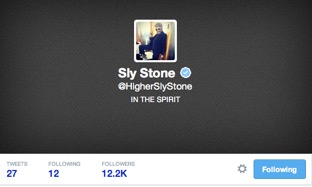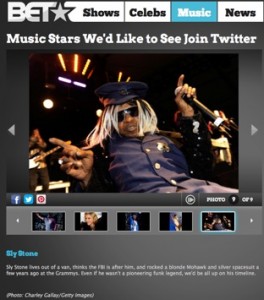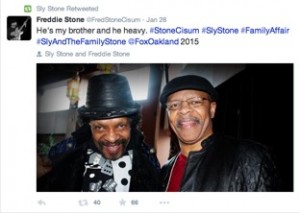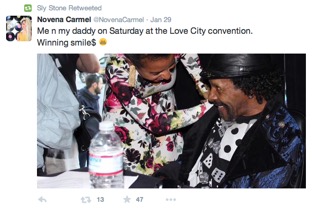
Sly Stone was on top of his game in the late ’60s. He lit up San Francisco’s music scene as a radio DJ and record producer, then as bandleader and prime songwriter of the phenomenal Sly and the Family Stone. Between 1967 and 1969 the band cranked out eight singles, several of which topped the charts, and four albums, three within a year, culminating with Stand! They played celebration songs with exuberant harmonies, horn charts, and slapped bass lines never before heard: “Everybody Is A Star,” “Fun,” “Hot Fun in the Summertime,” “Life,” “M’Lady.” They rocked uplifting party jams: “Dance to the Music,” “I Want to Take You Higher,” “You Can Make It If You Try.” Message songs reflecting the political ferment: “Don’t Call Me Nigger, Whitey (Don’t Call Me Whitey, Nigger),” “Stand!” Songs like “Everyday People” that did all that and more. They took crowds by storm like no one else. A 3:30 am set at Woodstock roused the hippies from their sleeping bags to dance in the mud until sunrise, in an ecstatic call and response. “Wanna take you higher,” Sly demanded, and the crowd echoed back, “Higher!”
That kinetic positivity was soon eclipsed by its opposite. He became a chronic no-show, missing about a third of his concerts. Releases slowed to a crawl. In 1970, only the Greatest Hits, plus a reissue of 1969’s “Stand!”/”I Want to Take You Higher” single with its sides reversed. Then in 1971, the unprecedented There’s a Riot Goin’ On. What the hell happened? How did Sly get from the big bang of Stand! to the black hole of Riot?
Sly moved from San Francisco to L.A. in late 1969, where he was beset by a flock of hangers-on and gun-toting bodyguards who staged chaos in his spotlight, acting out paranoid, narcotic-fueled fantasies alongside Sly’s violent pitbull Gun. He got higher, but not in a good way. Pot, mushrooms and LSD were increasingly supplanted by cocaine and heroin, and he and his crew started using PCP on New Year’s Eve as the ’60s ended. Perhaps some of the new supplements were a way to cope with the relentless pace of their shooting stardom. Touring is inherently alienating, and fully charged Sly and the Family Stone performances would exhaust anyone, especially Sly, whose over-the-top onstage persona belied his shyness and deep stage fright. After a string of late arrivals and missed gigs, violence shadowed the band if they performed or not. Gatecrashers threw rocks at police at the Newport Jazz Festival. With Sly five hours late, fans tried to light a fire in the Constitution Hall orchestra pit in D.C. Before a free show at Grant Park in Chicago, tear gas and police dogs were unleashed, three were shot, hundreds arrested. Promoters started canceling out of fear or demanding five-figure bonds to ensure he would show up, adding pressure to every concert. Like baseball players relying on greenies to get through the season, Sly and his band had the need for speed that makes rock history a catalog of casualties. Sly had to find time to write and record more intricately arranged hits. Cocaine-fueled sessions ran all night or as marathons for days on end, mostly at his Bel Air home recording studio. Drug and alcohol abuse was an occupational hazard.
The Riot recording process was haphazard in other ways. Plenty of Sly fans came by to make music, like Miles Davis, Herbie Hancock, and Billy Preston, but no one kept session lists so no one’s too sure exactly which of them made it to the final album (though you can tell that is Bobby Womack singing on “Just Like A Baby”). Instead of recording at once as a band, they lay down separate tracks in isolation. Sly kept adding new parts on the same tapes, either overdubbing or erasing earlier parts.
Sly’s two tweets from the Malibu Beach Recovery Center suggested he was on the right path. Two days after Christmas 2011: “feeling good.” Good, though Riot suggests Sly would not consider that an unconflicted state of mind.
The resulting record sounds washed out, with the broad sonic spectrum of his ’60s hits gone, flattened. On some tracks, room tone and tape hiss are as loud as the instruments. His Riot gear featured a drum machine for the first time. His singles’ guitar and organ stabs gave way to wah-wah pedal moans. The record has a muddled, muddied, muffled sound. It doesn’t take you by storm. The sounds burble up from the murk to envelop you. If you like it, it feels like a cocoon. If not, it is more like a coffin.
The sound fits the message of the lyrics all too well. Riot has an undeserved reputation as political, thanks to its title, its cover art (a modified American flag: black instead of blue, suns instead of stars), and two song titles that mention Africa. It is seen as a rebuke to the optimism of his ’60s works, or as an apotheosis of the ’60s themselves. Sly himself disavowed that take in David Kamp’s 2007 Vanity Fair feature interview:
“People say Riot is about Sly Stone’s disillusionment with the 60s dream,” I tell him.
“Oh, really?” he says, genuinely surprised.
“Yes, what do you make of that?”
“That may be true,” he says.
“May be?” I say. “It’s you! Is it true or isn’t it?”
“I mean, I’ve never thought about it like that,” he says. “I don’t really feel like I’m disillusioned. Maybe I am. I don’t think so, though.”I ask if his writing was impacted by any of the period’s ugliness—the Kent State killings, the Attica prison riots, the M.L.K. and R.F.K. assassinations. “Um, I paid attention to it,” he says, “but I didn’t count on it. I wasn’t going on any other program or agenda or philosophy. It was just what I observed, where I was at.”Still, Stone doesn’t totally dismiss those who ascribe loftier meanings to the album. When I ask him if he regards There’s a Riot Goin’ On in any way as a political statement, he says, “Well, yeah, probably. But I didn’t mean it to be.”
Riot’s politics are never expressed in the polemical terms of mass movements. In “Poet,” he sings, “My only weapon is my pen, and the frame of mind I’m in.” Any agenda is personal, withdrawn. The title track is nothing but a title and a track listing, a conceptual prank that lasts 0:00, a riot in name only. Riot is a drug record, steeped in the fervent mind of a frozen user. The lyrics are more likely to cancel each other out than resolve to make a coherent point. So the record opens with “Luv n’ Haight,” singing:
Feel so good inside myself Don’t want to move
Feel so good inside myself Don’t need to move
As I grow up I’m growing down
And when I’m lost, I know I will be found
The song entrenches further: “Feel so good cannot move.” But then, with no apparent change in external motivation, the sense changes: “Feel so good, feel so good, I want to move.” Like an addict sedate until bolted by the need to score another hit, suddenly there’s a riot going on in the mind, so much mental activity that the body is petrified. Riot depicts two states of mobility: stasis, followed by knee-jerk reaction. The record sings about life at a standstill and moving not by acts of will but only when neurological impulses are triggered. Paralysis and compulsion. A horror movie shot from the zombie’s perspective. No more summoning listeners to stand, or get higher. On “Africa Talks To You ‘The Asphalt Jungle,’” Sly calls out: “Timber! All fall down!” On “Family Affair,” the hit single, moving and staying put are the only options, and neither is possible: “You can’t leave ‘cause your heart is there, but sure, you can’t stay, ‘cause you been somewhere else.” It would feel claustrophobic if Sly did not sound so content.
The last two songs are “Running Away,” which mocks someone for trying to physically escape problems (“you’re wearing out your shoes”), then “Thank You For Talking To Me Africa,” which crystallizes the tipping point moments when “I begin to stop” and “I begin to run.” Either way, it is focused on anticipated motion without the motion itself. “Thank you for the party, I could never stay. Many thangs is on my mind, words in the way.” It is a snail’s-pace remake of their 1969 number-one single, “Thank You (Falletinme Be Mice Elf Agin).” The single buried the last verse in the mix; on Riot its corrosive view of life’s choices is easier to make out, but not to accept: “Flamin’ eyes of people fear, burnin’ into you. Many men are missin’ much, hatin’ what they do. Youth and truth are makin’ love, dig it for a starter. Dyin’ young is hard to take. Selling out is harder.” It makes the refrain that ends the record, “thank you for letting me be myself again,” sound sardonic. Being yourself is small comfort if you’re caught in a trap.
Sly Stone did not die young and did not sell out. He ran away, holing up in Bel Air after Riot and “Family Affair” both hit number one in 1971. He was not often back on the charts, as thousands of funk followers picked up his signature sound and took his place. Rumors spread about his declining physical, mental, and financial state. He became a renowned recluse, estranged from much of his family and band. Stand! had transformed pop music by foregrounding the rhythm section, but after Riot both Greg Errico (drums, @gregerrico) and Sly’s cousin Larry Graham (bass, @GrahamLarry) quit. (Larry left in fear for his life. Sly believed Larry was plotting to kill him so his bodyguards assaulted Larry’s bodyguards in a Clockwork Orange-inspired melee.) Public appearances became sporadic after some splashy events in 1974—a week co-hosting the Mike Douglas Show, his wedding with Kathy Silva onstage at Madison Square Garden. They divorced after Sly’s pitbull mauled their 2-year-old son, and Silva found out about Sly’s baby daughter with bandmate Cynthia Robinson (trumpet, vocals). Sly’s deal with Epic Records ended after four more ’70s albums of diminishing returns, then two for Warner Brothers disappeared as disco waned. He was arrested for cocaine possession in 1973, 1979, 1981, 1982, 1986, and 1987, among other crimes. He faced several court-ordered stays at rehab centers, forfeited thousands in bonds over ducked court appearances, and liens and penalties for failing to pay child support and the IRS. He spent a year at George Clinton’s Michigan farm to dodge a dealer he had burned, and lived under the alias Sylvester Allen in Newark and Wilton, Connecticut, fleeing from narcotics charges.
As if playing sound clusters on a piano by dropping three fingers at once, Sly banged out these triads: jnk, jkh, vft, drd, kok, o;l, oki, hy, frt. From ze goolash he chose clusters of letters that sit next to each other on the keyboard. What an outsider sees as nonsense may still have a preordained design.
Sly excels at sabotaging comebacks. He barely spoke with the band at their Rock and Roll Hall of Fame induction ceremony in 1993, stepping to the podium only after his band members finished their speeches. He went 19 years without playing live until a 2006 Grammys showcase in the wake of Different Strokes by Different Folks, a Starbucks-released tribute CD of covers by Sly acolytes. Introduced by Dave Chappelle (“Folks, the only thing harder than leaving show business is coming back”), Sly took the Grammy stage in a blond mohawk and sunglasses, played keyboard and sang a few lines of “I Want to Take You Higher,” barely audible, then walked off-camera before the song ended in disarray. Some of his band, including Errico, Jerry Martini (tenor sax, @TheFamilyStone2), and Dawn Silva (vocals, @DivasofFunk) toured without him as the Family Stone Experience. Others from Sly’s band—sister Vet Stone (vocals, @Vettox) and Cynthia, with Sly and Cynthia’s daughter Sylvette Phunne Robinson (keyboards, vocals, @RawSyl)—also had a Sly tribute band, Phunk Phamily Affair, later rechristened the Family Stone, with whom Sly started to play hit-and-miss reunion shows, including a European tour in 2007. He would come onstage midway through and leave at will. At Coachella in 2010 he told the heckling crowd, “Don’t get mad at me. As a matter of fact, if you do, lie and say you didn’t. Every honest man will lie when they need to.” He spent much of that performance cutting songs short, asking how long he had to perform to get paid, and railing against his ex-manager: “F—k slander. The white boy’s name is Jerry Goldstein.” Sly was suing Goldstein, alleging fraudulent misappropriation of millions in royalties. After Coachella, Goldstein counterclaimed for defamation.
After his public retreat it is a surprise that Sly would want the spotlight at all now. The glare brought him attention he could not stand and turned his life upside down. Yet here he is, gamely trying his hand at social media as @HigherSlyStone. His Twitter communiqués are as fractured and erratic as his public image and they have plenty to tell us about Sly Stone today, Riot, and Twitter itself.
Like Riot, Twitter has a reputation as a political force it hardly deserves. Twitter is a medium for any message and its only agenda is promoting its own use. Messages and their messengers can  rack up a miniature version of celebrity on Twitter, where the only thing paid is attention, but it is fickle, fleeting. There is always something next. As topics recur across the system, they bubble up as trends, generating a diffuse feedback loop of further attention and response until the next trend comes along. The ebb and flow ensures that Twitter feeds have no fixed content and wears down the centrality of any one message, just as the accretion of recordings dubbed and redubbed over the same stretches of tape gave Riot its muted, dulled tone.
rack up a miniature version of celebrity on Twitter, where the only thing paid is attention, but it is fickle, fleeting. There is always something next. As topics recur across the system, they bubble up as trends, generating a diffuse feedback loop of further attention and response until the next trend comes along. The ebb and flow ensures that Twitter feeds have no fixed content and wears down the centrality of any one message, just as the accretion of recordings dubbed and redubbed over the same stretches of tape gave Riot its muted, dulled tone.
Twitter is a stage on which everybody is a star. Its users self-consciously mediate the personae they put on display in a perpetual act of identity curation. That is far from the voice of Riot, a monologue intoxicated by its own perception of itself, seemingly without regard to how it is perceived by anyone else. Sly had presaged Riot’s paranoid standstill on Stand! in “Somebody’s Watching You,” describing the downside of popularity where “jealous people like to see you bleed” and “a downfall/happens at the end of every line.” On Twitter the entire point is that somebody’s watching you. Success is measured in followers. No wonder he never seems at home there, and never alights there too long. His indifferent use of Twitter violates the ground rules of the direct-to-fan dialogue now expected of celebrities, sabotaging this platform too.
 Sly Stone joined Twitter on March 23, 2011, eight days after he turned 68, on the verge of launching his first new studio album since 1982. His profile pins his location as “IN THE SPIRIT,” neatly capturing both Twitter’s disembodied presence and his own phantom fame. As he adopted his new @HigherSlyStone alias, he introduced himself by both his stage name Sly Stone and his birth name Sylvester Stewart, as if he was not just playing another role here. Interviewed for the funk episode of WGBH’s Rock and Roll coffee table book/TV series, his siblings and onetime bandmates Freddie Stone (lead guitar, vocals, @FredStoneCisum) and Rose Stone (keyboards, vocals, @rosestonenation) had also distinguished their brother Sylvester from his Sly persona:
Sly Stone joined Twitter on March 23, 2011, eight days after he turned 68, on the verge of launching his first new studio album since 1982. His profile pins his location as “IN THE SPIRIT,” neatly capturing both Twitter’s disembodied presence and his own phantom fame. As he adopted his new @HigherSlyStone alias, he introduced himself by both his stage name Sly Stone and his birth name Sylvester Stewart, as if he was not just playing another role here. Interviewed for the funk episode of WGBH’s Rock and Roll coffee table book/TV series, his siblings and onetime bandmates Freddie Stone (lead guitar, vocals, @FredStoneCisum) and Rose Stone (keyboards, vocals, @rosestonenation) had also distinguished their brother Sylvester from his Sly persona:
WGBH: How would you characterize Sly?
Freddie: Um, well, Sly is, um Sly is more or less someone that people know to be, um, Sly. Sylvester is someone else.
Rose: That’s, we know Sylvester.
Freddie: We know the difference between Sly and Sylvester. And if you were to talk to Sylvester, he likes Sylvester better than he likes Sly. Sly is more or less something that has come about because of, uh, growing, learning, living, pressures, struggles. And the image that you must continue to project … The Sylvester, the part that I know, is the person that people need to know. Because he is the real genius. Sly is just someone that, you know, people make up, he made up.
Sly’s second tweet, four days later, a pseudo-curse a la Carnac the Magnificent, presented an absurdist goofball side of Sly long obscured by his reclusive persona. Fans can warm to inside jokes when offered a way in but Sly established distance, leaving the context unexplained.
absurdist goofball side of Sly long obscured by his reclusive persona. Fans can warm to inside jokes when offered a way in but Sly established distance, leaving the context unexplained.
Early on April 1, 2011, Sly quoted his daughter Novena Carmel (multi- instrumentalist, vocals, @novenacarmel, @BabyStoneMusic, @zoowaxmusic), who may well explain how Sly got on Twitter. You can imagine her suggesting it as a way to connect with his fans and Sly playing along. She discussed teaching him the ropes but he was already properly sourcing quotes (“via”), so he had learned how the medium is used. Whenever he doesn’t follow its rules of engagement, that must be by choice.
 Later that April Fools’ Day, Sly was arrested at a vehicular stop and charged with cocaine possession again. His two-week long streak without saying anything paranoid or depressing on Twitter ended April 3. “THIEVES ARE BEING SURROUNDED.” Now there’s the Sly we expect. If not the Sly we want, perhaps the Sly we deserve. No telling which alleged thieves he had in mind: the LAPD who took his stash, Jerry Goldstein and his partners, or some other perceived antagonists. Never addressing his arrest, Sly’s mercurial mind flowed to a new topic. It occurred to Sly to tweet love to Japan, where he had played fourteen shows as Rufus’ featured artist at the Blue Note in Tokyo the previous winter.
Later that April Fools’ Day, Sly was arrested at a vehicular stop and charged with cocaine possession again. His two-week long streak without saying anything paranoid or depressing on Twitter ended April 3. “THIEVES ARE BEING SURROUNDED.” Now there’s the Sly we expect. If not the Sly we want, perhaps the Sly we deserve. No telling which alleged thieves he had in mind: the LAPD who took his stash, Jerry Goldstein and his partners, or some other perceived antagonists. Never addressing his arrest, Sly’s mercurial mind flowed to a new topic. It occurred to Sly to tweet love to Japan, where he had played fourteen shows as Rufus’ featured artist at the Blue Note in Tokyo the previous winter.
On April 6, Sly raised the specter of imaginary challengers again, this time daring him to release some home recordings (“WAS TOLD I DIDNT HAVE THE BALLS TO DO THAT”). Sly responded to this ghost of a challenge with an empty offer. Such a tease might work as a P.R. ploy if you deliver the goods once you whet the appetite, but @HigherSlyStone didn’t go on to share any of his music. What looked like his first use of Twitter to directly address his fans was purely rhetorical. @HigherSlyStone never responds to replies or follows up on his old messages. He will not give the people what they want and makes sure to let them know it. His next tweet was another shout-out to Japan, as if he had not done that three days earlier.
A week after his latest arrest, Sly’s April 8, 2011 tweet offered one way to justify paranoia or mistrust. He rephrased one of his Coachella musings as a question so loaded as to guarantee a cynical answer. “IS IT TRUE THAT EVERY HONEST MAN WILL LIE WHEN HE NEEDS TO.” When you start with the assumptions that some lies are necessary, and that people who need to lie will, it is easy to conclude that no one can be trusted, QED. That logic trap is 
as corrosive as ![]() the dying young/selling out verse at the end of Riot.
the dying young/selling out verse at the end of Riot.
His lawsuit explained why such a paranoid koan would ring true for him. Sly alleged that Goldstein took over as his manager in the late ’80s when Sly was a fugitive in arrears to the IRS, without a record label, and addicted to cocaine and sedatives. To cover  old debts, Sly had already given away all rights to performance royalties for his recordings, one of the two main revenue streams that keep musicians going past their prime. The other stream, control over his songs’ publishing, Sly had sold to Michael Jackson in 1985, but he kept the songwriter’s share of future publishing royalties. That is what he alleges Goldstein stole.
old debts, Sly had already given away all rights to performance royalties for his recordings, one of the two main revenue streams that keep musicians going past their prime. The other stream, control over his songs’ publishing, Sly had sold to Michael Jackson in 1985, but he kept the songwriter’s share of future publishing royalties. That is what he alleges Goldstein stole.
Sly’s every-honest-man tweet ended his busiest period on Twitter: eight tweets in seventeen days, or one almost every two days. That is almost invisible by most Twitter users’ standards, and his disinterest in the forum can be seen in the slower pace and increasing time lag between tweets. His ninth tweet was six weeks later, in May 2011. He had four more that summer (including three on July 28), two that fall, and one more in December brought his 2011 total to fifteen. Then another eight tweets in 2012, four more in 2013, none in 2014, and just two so far in 2015, both retweets of pictures with family. As with many Twitter users, an initial burst of interest preceded a long decline. Sly’s declining use progressed mathematically as if he is the Zeno of Twitter, always finding a way to give it half as much attention as he gave before, but never quite all gone.
The engine of Twitter, like all online social media, is its users’ desire for attention, garnered when other users mention, retweet, or follow them. Fame feeds itself: Sly has more than 13,000 followers on Twitter and picked up at least 1,000 of them in 2014, when he tweeted nothing. Sly only followed twelve people himself, all musicians: family (@FredStoneCisum, three of Novena’s handles), some he has played with and admired (@george_clinton, @MsGladysKnight), and a few of Sly’s many ardent admirers (@questlove, @CeeLoGreen). Sly’s May 20 tweet again showed how well he understands this social media attention economy. He suggested that his followers should follow his brother, and he knows the lingo, #FF for “Follow Friday,” Twitter’s weekly attention- sharing ritual. It could also have been the kind of wordplay Sly loves (Follow Freddie).
![]() He is wise to divert the spotlight, which burned him out when it fell on him directly. On June 3, 2011, two Fridays later, he shared more spotlight, this time with someone who already gets plenty: @fatbabybella a/k/a Erykah Badu, one of his funk inheritors, who had been performing in her own blond mohawk not long before. On June 15, 2011, after a brief hospital stay postponed his arraignment, Sly pleaded not guilty to cocaine possession in Los
He is wise to divert the spotlight, which burned him out when it fell on him directly. On June 3, 2011, two Fridays later, he shared more spotlight, this time with someone who already gets plenty: @fatbabybella a/k/a Erykah Badu, one of his funk inheritors, who had been performing in her own blond mohawk not long before. On June 15, 2011, after a brief hospital stay postponed his arraignment, Sly pleaded not guilty to cocaine possession in Los  Angeles County Superior Court. That day in court drew more headlines than would the August release of his comeback record, I’m Back! Family & Friends, the latest in a string of titles that try too hard to convince you that he has still got it: his last for Epic/Columbia, Heard Ya Missed Me, Well I’m Back, and Warner’s two neglected disco-era releases, Back on the Right Track and Ain’t But The One Way. In 2011, with his major-label backing gone, I’m Back! was released by the goth-indie Cleopatra Records. It is mostly new versions of Sly’s old hits, with guest spots by other icons: “Hot Fun in the Summertime” with fellow funk star Bootsy Collins, and less intuitively, one song apiece performed with Jeff Beck, Johnny Winter, Ann Wilson, Carmine Appice and Ray Manzarek. The songs were retreads and so was the concept, since most of the covers had already been covered or remixed by other artists on the 2005 Starbucks record. But now Sly was part of his own tribute band.
Angeles County Superior Court. That day in court drew more headlines than would the August release of his comeback record, I’m Back! Family & Friends, the latest in a string of titles that try too hard to convince you that he has still got it: his last for Epic/Columbia, Heard Ya Missed Me, Well I’m Back, and Warner’s two neglected disco-era releases, Back on the Right Track and Ain’t But The One Way. In 2011, with his major-label backing gone, I’m Back! was released by the goth-indie Cleopatra Records. It is mostly new versions of Sly’s old hits, with guest spots by other icons: “Hot Fun in the Summertime” with fellow funk star Bootsy Collins, and less intuitively, one song apiece performed with Jeff Beck, Johnny Winter, Ann Wilson, Carmine Appice and Ray Manzarek. The songs were retreads and so was the concept, since most of the covers had already been covered or remixed by other artists on the 2005 Starbucks record. But now Sly was part of his own tribute band.
July 28, 2011, two weeks before I’m Back! came out, was Sly’s busiest day ever on Twitter. Three whole tweets, each far off-message from any promotional hype Cleopatra could have wanted. Heagain teased a song that he did not deliver. He praised Clive Davis, Columbia’s president through Sly’s glory years. And he offered up another unexplained inside joke: “From among ze goolash We chose Same cluster of sounds.” Meaning perhaps, given the infinite choice of combinations available in the universe of sound, we happened to pick out the exact same ones we had used before. Not much of an endorsement for an album loaded with re-recorded Sly simulacra. It highlights the absurdity of any artist trying to give the people what they want long after the artist, the crowd, and what they want have all changed.
![]()
![]()

A month later, on August 31, Dutch filmmaker William Alkema (@slystonefilm) tweeted that he had helped Sly with his first TV appearance in 20 years, for the TVOne network’s Unsung. Alkema, whose Sly documentary Comin’ Back For More had
toured Europe and was then on the festival circuit in the  U.S., soon found an unusual way to call attention to his project. He co-authored a September 26, 2011 New York Post article, distilling the most sordid tell-all stories from his interviews to portray Sly as homeless, living in a camper van in Crenshaw, debilitated by drug use:
U.S., soon found an unusual way to call attention to his project. He co-authored a September 26, 2011 New York Post article, distilling the most sordid tell-all stories from his interviews to portray Sly as homeless, living in a camper van in Crenshaw, debilitated by drug use:
“A retired couple makes sure he eats once a day, and Stone showers at their house. … Sly is disheveled, paranoid—the FBI is after him; his enemies have hired hit men. He refuses to let The Post into his camper, but, ever the showman, poses flamboyantly with a silver military helmet and a Taser in front of his Studebaker. … He works constantly on new music, often staying up for two days straight, then sleeping for the next two.”
Alkema reported that Sly said, “I like my small camper. I just do not want to return to a fixed home. I cannot stand being in one place. I must keep moving.” But his compulsion to move was as frozen as on Riot. The retired couple’s son was Sly’s assistant and driver. To keep recording, Sly left the van parked by their house, tethered to extension cords powering his laptop.
Nothing sells like a tale of a fallen star. Amid the fallout from the Post article Novena tweeted, “if someone CHOOSES to live in a camper van, that doesn’t necessarily make them ‘homeless’ FYI. #holdyourjudgment” and “Don’t BELIEVE everything you READ. As they say in showbiz, if it BLEEDS it LEADS.” AOL’s SplashNews ran a video interview on September 27 with Sly laying on his bed in the van, saying he is clean, he is not using cocaine at the  moment, he had not done any in a week and a half, and he had picked out a rehab facility. Also on September 27, several ex- bandmates told TMZ that they wanted to help Sly get through it. On September 28, Sly retweeted his frequent collaborator George Clinton’s tweet, “Letuz take u Higher,” which included a minute-long clip of Sly singing onstage beside George, then leaving to cheers. It was as close as Sly would get to using Twitter for spin control. But his latest comeback was scotched.
moment, he had not done any in a week and a half, and he had picked out a rehab facility. Also on September 27, several ex- bandmates told TMZ that they wanted to help Sly get through it. On September 28, Sly retweeted his frequent collaborator George Clinton’s tweet, “Letuz take u Higher,” which included a minute-long clip of Sly singing onstage beside George, then leaving to cheers. It was as close as Sly would get to using Twitter for spin control. But his latest comeback was scotched.
Sly agreed to do 90 days in rehab, his eighth and longest stint yet, in a plea bargain to avoid jail time for his April bust. On October 22 @slystonefilm tweeted, “Sly entered into rehab. Let’s pray or wish his treatment will be succesfull.” The next day, Sly devotee/Red Hot Chili Pepper bass player Flea (6,000+ tweets, 1,100,000+ followers) tweeted, “no one will ever be better than @HigherSlyStone.” On November 22 Sly’s brother Freddie, now a pastor in Vallejo, tweeted, “My brother sly has been in rehab now for 30 days, and looks good. Praise God, yes I said it. Praise God. LOl.”
Sly’s two tweets from the Malibu Beach Recovery Center suggested he was on the right path. Two days after Christmas 2011: “feeling good.” Good, though Riot suggests Sly would not consider that an unconflicted state of mind. Sly’s January 3, 2012 tweet excavated a more hopeful message from the Riot era, quoting himself: “It’s not the teaching, it’s the learning.” That line’s from “In Time,” the first track on 1973’s Fresh, the first Sly and the Family Stone album after Riot. “In Time” drew on Riot’s imagery:
![]()
buzzing brains numbed past feeling, and bodies moving without direction.
 (“Something moving in the mind of a doer, in time, feel a little newer … I switched from coke to pep and I’m a connoisseur.” “‘Cause there’s a method in the madness of the thinkin’.” “I felt so good I told the leader how to follow … So glad I could not feel indeed so very hollow.” “There’s a reelin’ when you don’t know what you’re doing.”). But he quoted a line that resounds with a higher purpose. People are hardwired to follow basic animal instincts—the Four Fs: feeding, f—king, fighting and fleeing. Any zombie can do those. But teaching and learning, which are just as essential to evolution, require willpower.
(“Something moving in the mind of a doer, in time, feel a little newer … I switched from coke to pep and I’m a connoisseur.” “‘Cause there’s a method in the madness of the thinkin’.” “I felt so good I told the leader how to follow … So glad I could not feel indeed so very hollow.” “There’s a reelin’ when you don’t know what you’re doing.”). But he quoted a line that resounds with a higher purpose. People are hardwired to follow basic animal instincts—the Four Fs: feeding, f—king, fighting and fleeing. Any zombie can do those. But teaching and learning, which are just as essential to evolution, require willpower.
After one of Novena’s visits with Sly at the rehab center, he retweeted her Instagram picture of the two of them on January 7, adding, “we look gooood!” The acidity of his tweets that reflect on the music industry leaves no trace on his communications with Novena, which all show genuine love and affection. She and others in Sly’s family stood by him and helped reanimate him. Sly checked out of rehab on January 22, 2012.
 Oblivious to @HigherSlyStone, BET’s January 30 clickbait hack job, “Music Stars We’d Like to See Join Twitter” included a demeaning Coachella picture and a look-at-the-freak blurb: “Sly Stone lives out of a van, thinks the FBI is after him, and rocked a blonde Mohawk and silver spacesuit a few years ago at the Grammys. Even if he was not a pioneering funk legend, we’d be all up on his timeline.” If Sly Stone tweets and no one hears it: Timber. All fall down.
Oblivious to @HigherSlyStone, BET’s January 30 clickbait hack job, “Music Stars We’d Like to See Join Twitter” included a demeaning Coachella picture and a look-at-the-freak blurb: “Sly Stone lives out of a van, thinks the FBI is after him, and rocked a blonde Mohawk and silver spacesuit a few years ago at the Grammys. Even if he was not a pioneering funk legend, we’d be all up on his timeline.” If Sly Stone tweets and no one hears it: Timber. All fall down.
On March 3, 2012 Sly tweeted, “I HAVE BEEN FINDING THINGS ABOUT MYSELF THAT WILL MAKE THE MOST INTERESTING BOOK EVER.” You’d hope that could be his honest report after three months of self-reflection in rehab, though as usual he gave Twitter no insight about what those interesting things might be, and it might just have been a backhanded review of Vet’s self-published tell-all memoir, which took its title from “Family Affair”: Blood Is Thicker Than The Mud. Her book, released in 2011 while Sly was in rehab, details the years of behind-the-scenes machinations within the family to get Sly back to the stage. It could well have struck Sly as oversharing. Sly was interviewed again for Unsung on his 69th birthday. The special dwelled on his years in decline. It aired on June 25, 2012. Sly’s tweet the day after appeared to be an indirect, dismal response: “I don’t like the word happiness anymore.” Unbowed, Sly let himself be subject to another documentary, VH1’s Finding the Funk. On July 23, 2012, Sly retweeted a picture of Nelson George interviewing him, as posted to Instagram by Novena’s bandmate Derek G. Taylor (drums, @derekgtaylor).
 Then on August 1, 2012, Sly spoke “in other words,” beyond language itself. If you don’t like some words like happiness anymore, why use any at all? (Many thangs is on my mind, words in the way.) At first it looks like a pocket tweet, gibberish you’d get by pounding random letters instead of typing words, but there is a method in the madness. As if playing sound clusters on a piano by dropping three fingers at once, Sly banged out these triads: jnk, jkh, vft, drd, kok, o;l, oki, hy, frt. From ze goolash he chose clusters of letters that sit next to each other on the keyboard. What an outsider sees as
Then on August 1, 2012, Sly spoke “in other words,” beyond language itself. If you don’t like some words like happiness anymore, why use any at all? (Many thangs is on my mind, words in the way.) At first it looks like a pocket tweet, gibberish you’d get by pounding random letters instead of typing words, but there is a method in the madness. As if playing sound clusters on a piano by dropping three fingers at once, Sly banged out these triads: jnk, jkh, vft, drd, kok, o;l, oki, hy, frt. From ze goolash he chose clusters of letters that sit next to each other on the keyboard. What an outsider sees as  nonsense may still have a preordained design.
nonsense may still have a preordained design.
With Sly’s I’m Back! comeback effort long past, he has barely touched @HigherSlyStone in three years. Incredibly, when he does, it is no longer a  bummer. The account was silent until December 18, a day after
bummer. The account was silent until December 18, a day after  Novena played a show with cameos from Sly and George Clinton, then tweeted to them, “I love my family so much! Their support means the WORLD to me. Legendary in the world and in my heart.” Sly responded, “love you baby girl.” Just the sort of thing a dad should say. A month later she posted another picture of Sly to Instagram. He both retweeted it and made it his new Twitter profile picture so now he could see himself, or at least let himself be seen, through his daughter’s eyes.
Novena played a show with cameos from Sly and George Clinton, then tweeted to them, “I love my family so much! Their support means the WORLD to me. Legendary in the world and in my heart.” Sly responded, “love you baby girl.” Just the sort of thing a dad should say. A month later she posted another picture of Sly to Instagram. He both retweeted it and made it his new Twitter profile picture so now he could see himself, or at least let himself be seen, through his daughter’s eyes.
![]()
Sly has not deigned to use Twitter as a tool to generate hype for new releases. In the summer of 2013, he showed up at a press event in Berkeley as Sony Legacy finalized and issued a 5-CD retrospective box set, Higher!, but @HigherSlyStone had no comment about that. Instead he gave us two tweets quoting lyrics from the hundreds of songs he had written and recorded in his home studio or the camper van after the major labels moved on. Both of those lyric tweets were affirmations, not in the Riot vein. The first, on May 17, recalled the optimism of his early hits. “When you wind up making your mind up / That’s when you find up instead uh down.” As before, everything’s happening in the head, but if not actual motion there is at least direction, a possible way out from the wilderness. The second, a month later, was even better. Not just an affirmation, but one framed in the language of twelve-step recovery, in which admitting one’s helplessness over addiction (“something must be done/and there’s nothing I can”) is the necessary first step away from the void. That stage requires accepting that truly anything would be better than more nothingness. Sly was able to express that idea in a language that, as in “Luv n’ Haight,” speaks of compulsion. He sounded true to his character.



From ze infinite goolash of things that one might do, Sly picked something that is also true to form. After another six months away from Twitter, on December 10, 2013, Sly shared something he has been up to: getting good enough at chess to kick ass. Chess is fitting for someone who loves head games and spent years of addiction contemplating his next move, anticipating reactions and consequences, putting up defenses and setting traps and then striking without warning. Sly’s version of a chess brag is also convoluted enough to celebrate. It is not one of those self-conscious social media humblebrags that try to ward off criticism with preemptive self-deprecation. He states forthrightly that he will beat one of your friends four times out of four. But he shows some humility, since your other friend he is not so sure about.
The only marks Sly left on Twitter in 2014 came from others. On February 4, the judge in his lawsuit against Goldstein issued a ruling in Sly’s favor, that his Malibu rehab clinic could not intervene to force Sly to use any award from the case to pay off his $137,500 rehab bill. Sly did not take to Twitter to celebrate, but he retweeted Novena’s excited message about Sly’s scenes in Finding the Funk, which premiered that night. Finally, here was a documentary less focused on Sly Stone the person and the mud he has been through than about the music itself, where his legacy is unquestioned. This tribute gave Sly his due respect. He deserved to share that excitement, though he has deleted his retweet later in 2014, while he pared down the number of people he follows on Twitter from twelve to nine. (Bye-bye, Cee-lo.) Then in December 2014, Liz Phair (3,000+ tweets, 20,000+ followers) bumped into him in a parking lot and tweeted a picture, noting that Sly happened to be walking around with a bass.
A happy ending would seem to be the least likely ending to the story of Twitter-era Sly Stone. So Sly pulled one out of his sleeve. The mayor of Oakland proclaimed January 24, 2015 Sly and the Family Stone Day, kicking off a meet- and-greet convention in their honor that ended with more than a hundred local musicians performing “Stand!” There were panel discussions with Sly and some core band members, including Freddie, the current incarnation of the Famly Stone (Errico, Martini, Robinson, and Phunne), and Larry Graham’s replacement Rustee Allen, along with some of the band’s biographers, historians, reissuers and collectors. They participated in good spirits, making themselves available to fans’ questions and autograph requests, unmediated and fully engaged.
 And that was not all. Back in L.A. three days later, Sly won his lawsuit. The jury awarded him $5 million. Half of that was assessed against Sly’s production company, which had gone bankrupt in 2013, making it hard to collect, but the other half was due personally from Goldstein and his business partner
And that was not all. Back in L.A. three days later, Sly won his lawsuit. The jury awarded him $5 million. Half of that was assessed against Sly’s production company, which had gone bankrupt in 2013, making it hard to collect, but the other half was due personally from Goldstein and his business partner  Glenn Stone (no relation).
Glenn Stone (no relation).
Now Sly had something personal to share on Twitter. He did not tweet about the judgment that made headlines and vindicated his claims, perhaps finally listening to advice of counsel to steer clear of more defamation claims. (No more “f—k slander.”) Sly’s first tweets in more than a year were retweets of pictures from the Oakland celebration that caught him smiling with Freddie and Novena. 
2015 had more good news for Sly. The Library of Congress added Stand! to the National Recording Registry, Stephen Colbert’s first night hosting the Late Show featured a star-studded “Everyday People,” and Sony Legacy released another 4-CD box set, Live at the Fillmore East, of a series of 1968 shows with the group in top form. But the end of the year brought Sly bad news. Cancer took Cynthia Robinson, who passed at their daughter Phunne’s house. In his suit against Goldstein, the judge over turned the initial verdict, deciding Sly had legitimately assigned his royalties to the bankrupt production company. @HigherSlyStone did not mention any of it. If you do not share the highs, you do not have to share the lows. He also did not tweet about his surprise appearance at an August Family Stone gig in New Jersey, his last show with Cynthia. Errico and Sly had not shared the spotlight since the 2006 Grammys. He joined for just one song, “If You Want Me To Stay,” a regular part of the setlist whenever Sly performs now. His biggest hit after Riot, the song takes the perspective of a man who does not feel trapped. If someone wants him to stay put, he sticks around just long enough to be sure they notice when he is gone. It starts like this:
If you want me to stay, I’ll be around today
To be available for you to see
I’m about to go, and then you’ll know
For me to stay here I got to be me
You’ll never be in doubt, that’s what it’s all about
You can’t take me for granted and smile
Count the days I’m gone, forget reachin’ me by phone
Because I promise I’ll be gone for a while
